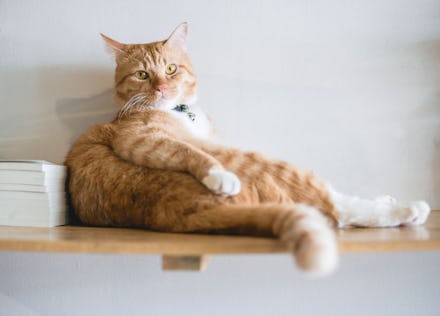We love fat cats, but is the extra weight dangerous for them?

I used to live with a gorgeously chonky cat. His name was Cucumber and he weighed 21 pounds. Cucumber spent most of his time draped languidly over furniture, snuggling, and posing for selfies with me. He went to live with my ex, and since then I’ve lost a lot of Instagram followers. More importantly, I lost a great companion. Like most folks, Cucumber’s life was more complicated than it looked on social media. He had kidney problems and some icky sores. It can be hard to tell if your cat is overweight — and while my vet didn’t come out and say that Cucumber was, she did tell me that he needed more water and exercise and less food.
Beauty standards for cats on the internet are very specific. The chonkier the better. There are hundreds of websites, blogs, and fan pages dedicated to showcasing the beauty of fat cats. But is a little extra weight detrimental to your cat’s wellbeing?
Recent data found that more than half of indoor cats are overweight to obese — and they’re suffering because of it. The research, which was sponsored by Purina, followed 44 cats over the course of a year in their struggle to lose weight. Unfortunately, as adorably reality-TV-worthy as this sounds, researchers concluded that being overweight affected these chonkster’s lives in major ways. Not only are overweight felines more likely to experience major issues like heart problems and diabetes, they have shorter life spans.
Now that I’ve got you sufficiently concerned, allow me to explain how to ascertain if your cat is, in fact, too thicc for their own good. Most domestic cats weigh around ten pounds, but this could vary from between 5 and 25 pounds, depending on breed. There are a couple of things you can do besides weigh your cat and obsessively google their breed. One way to gauge excessive cat-chub is to look for a waist.
I’m not joking. When you’re looking down at a standing cat, there should be a slight indentation above the hip bones. If that part of the body bulges, your cat might be overweight. It could also be fluff, though. When you’re looking at your cat from the side, their belly should slope up from the ribs toward the tail.
All of this feels a little chonk-shaming, but the truth is that cats tend to be happier when they aren’t overweight.
Older cats tend to have some sag here, but if there’s a round, floppy belly, your cat could be carrying too much weight. When you squeeze your cat, you should be able to feel their ribs and spine without poking them. None of these are exact methods, so if you suspect that your cat is getting to big, take them to their vet to see if he or she warrants any lifestyle changes.
All of this feels a little chonk-shaming, but the truth is that cats tend to be happier when they aren’t overweight. Veterinarians participating in the aforementioned research concluded that cats that lost weight “seemed to improve the cat’s daily functioning: mobility, grooming, and overall mood.” For the purposes of the study, half of the cats were given food-dispensing toys and half the cats were not. Interestingly, toys didn’t make a measurable difference in either weight lost or quality of life for the cats. Food rationing and probiotics are generally what seemed to help them get to their optimal weight.
A lot of pet owners feel callous rationing their fur baby’s food intake, but it seems like it’s just part of the domestication game. “Cats in nature eat 10-20 times a day,” Angie Krause, a Boulder-based veterinarian, told me for a previous cat-related story for Mic. But the reality is, that they're probably a lot less active indoors.
Cats live and eat by our schedules, which are counter to their own natural habits. So if we're going to ask felines to forgo their instinctual behavior for our own convenience, it’s on us to make sure that they stay healthy by monitoring their nutrition.